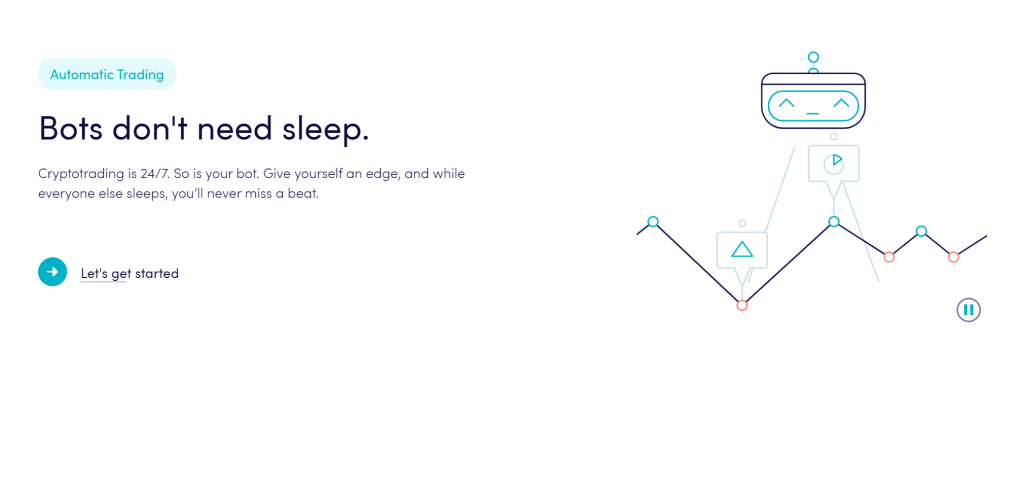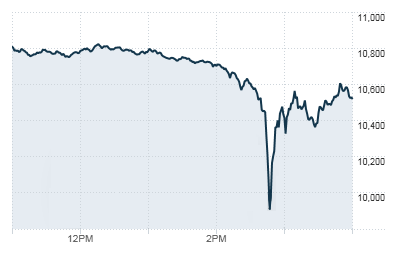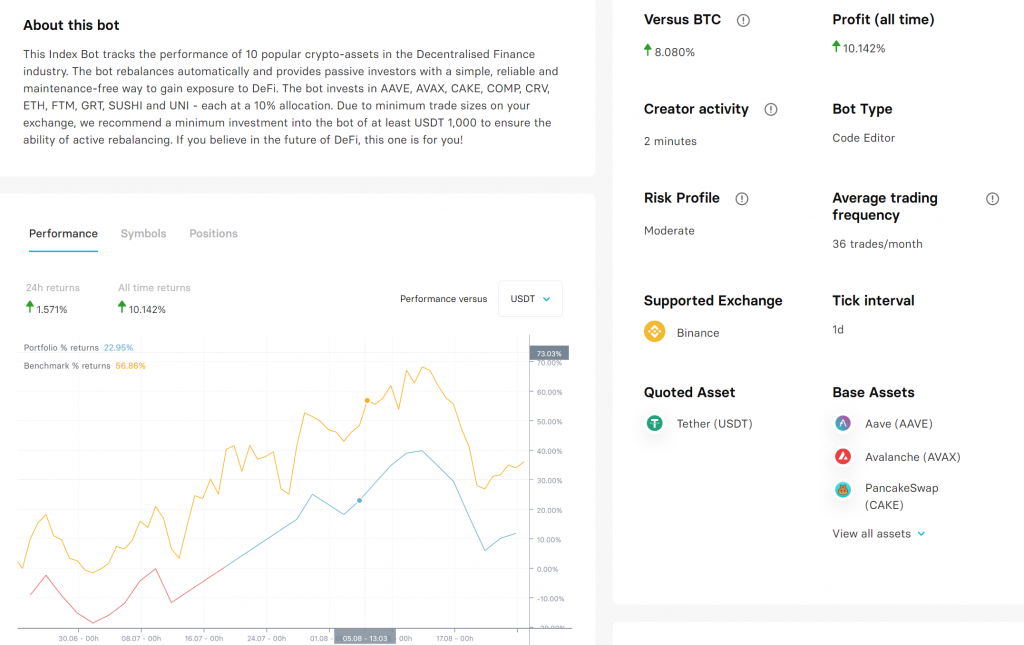Business
Trading Bots Are Rising Up

You’re reading the October 2022 issue of Automated Teller Machine (ATM). Each month, our ATM featured stories provide deep dives on impactful investment issues and trends.
All it takes is one internet search into “cryptocurrency trading strategies” to find yourself on the receiving end of a marketing pitch for high-frequency trading and computer algorithms.
These algorithms, known as trading bots, have become increasingly popular in the cryptocurrency market and can make hundreds or thousands of trades per second on your behalf. They’re often promoted in online groups or on trading websites, and come with promises about their ability to make you money quickly and easily.
It’s easy to assume that trading bots are a new innovation that’s come about as a part of the fintech (or financial technology) revolution. But these bots — which help to automate trading — have been around for decades. Once only accessible to institutional investors, they’ve only recently become more widely available to individual traders.
Today, anyone can create their own trading bot to do exactly what they want it to. A company like Trality allows you to create your own trading bot, which you can then connect to a crypto trading platform. Not only that, but there’s been a considerable increase in platforms and individuals either marketing and selling the bots they’ve created or even teaching tech-savvy consumers how to make their own.
But are they crystal balls that help everyday investors read the market? Or are they a handful of dice, presenting just as much risk as reward? And how are they shaping the future of trading?
Trading Bots: What They Are and How They Work
A trading bot is an automated computer program, or algorithm, designed to buy and sell assets more efficiently and effectively than a human could. These trading bots use many different types of data to make trading decisions based on set parameters.
Trading bots generally go through three stages to make a trade. First, the bot uses data analysis to gather information more quickly than individual investors would be able to. Next, the bot uses that data, along with the set trading parameters, to identify potential trades. Finally, the bot executes the trade.
Given the speed at which trading bots can operate — and the fact that the cryptocurrency market never closes — these bots are going through these same phases over and over again.

This can have a major impact on individual investors. Even with all the different technical analysis tools, charts and models at their disposal, investors can still be easily swayed by different emotional factors.
“Investors that opt to execute algorithmically are not so easily swayed by the emotions of the day and often make better buy and sell decisions.” says Leo Smigel, an algorithmic trader and the founder of Analyzing Alpha. “And this says nothing of that investor using a better alpha model to sift through thousands of stocks and data points.”
The History of Trading Bots

The first automatic trading system (ATS) dates back to the 1940s with the commodities and futures trader Richard Donchian. When Donchian launched his publicly-held commodity fund Futures, Inc., he used predetermined rules to generate buy and sell systems. Of course, these trading systems didn’t gain popularity outside of the institutional investing world quite the way they would later on, but Donchian’s innovation laid the groundwork.
The trading bots used now look nothing like the ATS developed by Donchian in the 1940s. Back then, developers were charting markets by hand and with ticker tape. Today’s algorithmic trading tools automatically buy and sell stocks, cryptocurrencies, and other assets based on preset parameters. No matter what your investment strategy, you (or a professional) can build a trading bot that will do it for you.
And unlike humans, who may be limited in the number of trades they can make in a day, trading bots can make endless trades.
Trading Bots vs. Robo-Advisors: What’s the Difference?
Trading bots are a part of a broader shift in the financial industry thanks to fintech. And one of the most significant fintech advancements came in 2008 when Betterment launched the first robo-advisor.
A robo-advisor is a digital platform that builds automated investment portfolios using computer algorithms. Most popular robo-advisors, including Betterment, build their portfolios using diversified exchange-traded funds (ETFs).
Like trading bots, robo advisors use algorithms to buy and sell investments without input from the investor themselves or a financial professional. But that’s where their similarities mostly end.
“While it’s true that both are based on what a computer can accomplish in markets, the people who use them and the results are vastly different,” says Charles Bender, the president of Fiduciary Wealth Management.
We are still seeing innovations in the robo-advisor space. For example, a new investment app called Q.ai helps you invest automatically in a variety of portfolios, just like a robo-advisor. But it also utilizes AI-powered hedging to try and protect your portfolio from market downturns, which is something very new to the robo-advisor world.
But at its core, there are two key differences between trading bots and robo-advisors: who they help and how they work.
Investors vs. Traders
To adequately compare robo-advisors to trading bots, it’s important to differentiate between investors and traders. Investors typically plan for longer-term financial goals, while traders frequently buy and sell assets for the purpose of making short-term profits.
The people who use robo-advisors tend to be investors. Due to their ease of use and built-in diversification, robo-advisors are especially popular for their retirement accounts. People can open their accounts, set up automatic transfers each month, and let their money grow on autopilot for decades.
But traders need something else. Rather than relying on the long-term growth of the stock market, traders try to take advantage of short-term price movements. And it’s these traders that this new generation of retail trading bots aims to serve.
It’s worth point out that while long-term investing has been a proven way to build wealth, active trading has a far more dubious track record. “It’s no secret that roughly 95% of day traders fail,” Smigel said.
But algorithmic trading isn’t at all the same as emotion-led human trading, argues Samuel Leach. “Retail traders often blow their accounts due to a lack of risk management, experience, or education. The algorithms are extending the retail traders’ investment experience by increasing their gains over a more extended period.”
Profiles vs. Price Swings
Robo-advisors and trading bots rely on different strategies for success. That’s because the end-goals of each differ by time horizon.
When you sign up for a robo-advisor, the platform asks you a variety of questions about yourself, your financial situation, and your goals. Then, it builds a diversified investment portfolio — usually consisting of ETFs — to help you reach those goals.
Generally speaking, robo-advisors use a buy-and-hold strategy. While they make adjustments to an investor’s portfolio over time, they generally invest in ETFs they can hold for a long period. And when building an investor’s asset allocation, they consider their risk tolerance, as well as the time horizon for their goals.
Trading bots, on the other hand, focus on a short-term strategy. A trader’s long-term financial goals and time horizon are largely irrelevant since the algorithm seeks to take advantage of momentary swings.
Stock Trading Bots vs. Crypto Trading Bots: Why They’re So Different
As we’ve already mentioned, institutional investors have been using algorithms for decades. And by Leo Smigel’s assessment, institutional investors account for over 85% of most stock markets. That means that most of the activity on most major stock markets are based on algorithmic trading.
At times this automatic institutional trading has led to wild price swings. Perhaps the most notable example of this would be the Flash Crash of 2010.
The Flash Crash
In May 2010, the stock market experienced the infamous “flash crash,” where hundreds of billions of dollars were wiped away in a matter of minutes. What’s unique about this particular crash is that it reversed course almost as quickly as it happened, with the market closing just 3% lower than the previous day. The entire crash lasted just 36 minutes.

It wasn’t until later that it was discovered that one of the instigators of the crash was a large mutual fund that had used spoofing algorithms to sell a large number of E-Mini contracts. Following the DOJ’s investigation into the incident, spoofing was banned in addition to “layering” and “front runner” algos.
While the 2010 flash crash in the stock market was caused by algorithmic trading, it’s important to point out that this isn’t typical. Generally speaking, the more institutional investors you have in a space, the lower the impact trading bots will have on volatility.
If anything, algos work to even things out, automatically buying and selling shares when stocks begin to move too quickly either up or down. But their impact on cryptocurrencies is a different matter.
“Volatility is always a direct function of liquidity,” says Bender. “When investing, it’s important to know which body of water you’re investing in. There’s a huge difference between making trades in a crypto market that has roughly a $1 trillion market cap across all coins versus the stock market which has a market cap that’s closer to $50 trillion.
Big Bots in a Small Pond
“During extreme price moves, these bots can trigger stop losses across many coins at once, causing crashes to be somewhat more extreme.”
Cryptocurrency overall is more volatile than the stock market, making it easier to profit (or lose out) from short-term price movements. And unlike the stock market, the cryptocurrency market never sleeps. Because the crypto market is running 24/7, so can your trading bots.
For this article, I talked to six experts across crypto and traditional stock trading, and they all believe that trading bots could compound the existing volatility issue in cryptocurrencies.
“During extreme price moves, these bots can trigger stop losses across many coins at once, causing crashes to be somewhat more extreme at times,” says Sebastian Ganjali, Head of Strategy, Kryll.io.
Exploiting an Immature Market
It’s worth noting that the volatility in the cryptocurrency market is exactly what makes it such an appealing target for day traders and those using algorithmic trading bots.
When prices start to plummet, bots can trigger sells before the clients loses big. But that can leave traditional crypto investors holding the bag. “While it can generally be safer for the bot users who have protections in place during these periods, old-school crypto HODLers take big hits and panic sell.”
There’s also a lot of arbitrage crypto trades being made with the help of bots. “Due to the number of exchanges, there are far more opportunities for arbitrage traders to find price discrepancies to take advantage of,” says Samuel Leach, the director of Samuel and Co Trading. “An example would be Bitcoin on exchange 1 for $20,000 and on exchange 2 for $20,100. Arbitrage algorithms would buy on exchange one and sell on exchange two in seconds, taking advantage of the price difference.”
As crypto continues to move mainstream and more regulations are placed on the market, both price volatility and the spread between exchanges are likely to diminish. That will ultimately be a good thing for investors. But, for now, bot traders still have an outsized influence on the “Wild West” crypto landscape.
Will the Growth of Bot Trading Lead to Ignorant Investors?
So now that we have a sense of the risk on the markets, what do bots mean for individuals?
If a computer chooses your investments for you — often at a pace you can’t even keep up with — can you really understand what you’re buying and selling? And if you can’t understand it, would you just forgo learning the basics of how investing works?

“I would say that many retail investors already don’t know exactly what they are investing in.” Boughedda said.
If that sounds harsh, think about the tools you might already be using. Index fund investing has become increasingly popular in recent years, partially due to its hands-off nature. But would most investors be able to tell you what stocks are in the index funds they hold? And more importantly, would they even be able to explain just how those funds work in the first place?
For a large swatch of passive investors, the answer to both questions would be a resounding “No.”
Many crypto investors have a different problem. “They’re often investing based on social media influencer hype and going off tips from their friends, says Kryll.io’s Sebastian Ganjali. This creates a speculative environment that can feel like an “online casino.”
For these investors, bot trading evangelists say that this new technology can actually improve investor education. “Yes, it would be more hands-off,” says Leach. “However, you’ll also have those individuals intrigued by the results and want to explore its inner workings and how it achieves the results.”
Ganjali agrees: With trading bots, the user gets a good idea of the strategy’s performance, how it performed during a bear/bull market, and how much risk they are exposed to during a drawdown…We find that traders and investors who are subscribing to these bots are learning as they go.”
The Finfluencers Have Entered the Building
Whether responsibly-deployed bots have the potential to help protect investors and improve their education remains to be seen. But what not’s an uncertainty is that there are a large number of “finfluencers” plugging these bots on their various platforms.
Amazing success stories are easy to find online. But what’s not always as easy to find out is where or not an influencer has an affiliate relationship with the creators of the bots that they’re recommending.

Keep in mind that just about anyone with coding abilities can create a computer algorithm to execute trades automatically and then market it. There’s little to no regulation around the use of trading bots, especially as it relates to cryptocurrency. The only restrictions are that any activities that would be illegal under any other circumstances are also illegal when done by a trading bot.
With this in mind, some financial professionals — especially those on the more traditional side of the financial industry — see trading bots as nothing more than a scam that will ultimately do more harm than good.
“Any investment product that starts with the most volatile asset possible, using affiliate marketing to promote it and sell it to unsophisticated investors is not something that is legitimate,” Bender says. “The reason you see them in forex and crypto is that those markets are not as regulated, and any sales copy you want to put out is probably not going to result in any negative repercussions.”
A Revolution? Or Just a Fad?
Over the past decade, we’ve seen technological advances in the financial world that no one could have foreseen. And moving forward, we’re likely to see more of the same. Because of that, it would be impossible to predict the exact future of bot trading.
The truth is that trading bots can significantly amplify volatility, especially in the crypto markets. And that alone could place them in the crosshairs of regulators down the line.
But on the flip side, bots allow individual investors to do the same type of trading that institutions have been doing for decades. And as the demand for decentralized finance tools continues to grow, so could the opportunities for trading algorithms.
The post Trading Bots Are Rising Up appeared first on Investor Junkie.




